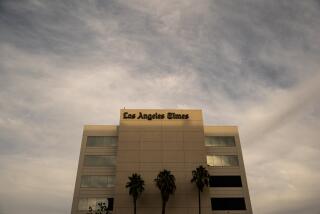Op-Ed, explained
TO SOME READERS, the Op-Ed page is a bit mysterious. I’ll be at a cocktail party, or in the bleachers at a Little League game, and the guy next to me will begin asking questions about just what it is we’re trying to do, and how we get it done.
Who are the writers who appear on the page? Are they speaking for themselves or the paper? How many articles come in every day, and how are they selected — and by whom? What are the criteria by which they’re judged?
I’m generally happy to talk about these subjects ad nauseam. But this week, with the move of the opinion pages from the California section to Section A, we decided we’d like to try to answer some of these questions for all our readers.
Our mandate, as we see it, is straightforward: to provide provocative, thoughtful commentary that is reasoned yet opinionated on a wide variety of subjects. The page itself has no ideological bent or political agenda; we want to provide the broadest possible range of opinions — from the left, from the right and, we hope, from authors whose politics are much harder to pigeonhole.
Sometimes we get e-mails complaining that the pieces we’ve run are biased. To which we reply: Of course they are! Unlike the articles in our news pages (where reporters endeavor to be objective), our articles are opinion pieces; bias and a point of view are expected. In that sense, they’re like the editorials that appear on the opposite side of the page (Op-Ed, get it?).
Unlike the editorials, however, our pieces do not reflect the opinion of the paper, its owners, its publisher or its editorial writers. Rather, the Op-Ed page is where individuals with no institutional connection to The Times can voice their opinions (opinions, by the way, that often disagree with the paper’s editorial stance). In addition, the Op-Ed page is home to our regular weekly columnists. More about them later.
As for our subjects, almost nothing is off-limits. We run articles on domestic politics, on foreign policy, on the great issues and controversies of the day in L.A., California and around the world. We also run personal essays and humor pieces, as well as articles on science and sports and movies and family life. The only unifying characteristic (we hope) is that all our pieces have an idea behind them and a point of view, and that they all stimulate some kind of intellectual engagement with the subject.
We’ve run pieces on whether fish feel pain, on what it’s like to be a baseball fan growing up in Hong Kong, on whether to engage or ignore North Korea, on the banning of transfats, on the agenda of the L.A. schools superintendent, on surfing in Munich, on the legacy of U.N. leader Kofi Annan, on several upcoming ballot initiatives and on how former Gov. Arnold Schwarzenegger’s childhood helped shape his approach to politics.
Our authors include people who have never (or rarely) written a word for publication. Others are better known, and they include novelists, historians, policymakers, humorists and activists. All are paid a modest fee for their contributions.
Submissions arrive in two ways: Either we solicit them or they’re sent to us by authors “over the transom” — i.e., unasked. In any given week, we receive 300 to 500 unsolicited submissions, most by e-mail. The vast majority do not make it onto the page (and, although we try to decline them politely, we are too overwhelmed to respond personally to every inquiry). In the end, we publish about 20 pieces each week on the Op-Ed and Sunday Opinion pages.
Our pages are put together on the second floor of the L.A. Times building by several full-time assigning editors as well as researchers, copy editors and an art director.
People often want to know whether we seek balance on the page. The answer, as best I can give it, is this: We want a page that is politically balanced over time — not leaning too heavily to the left or the right — but we don’t monitor it day to day, or count Democrats versus Republicans. Similarly, we seek diversity of thought and diversity of contributors — we want provocative ideas from people of all races, genders, religions, etc. — but again, we don’t try to balance the number of women to men on every single page.
In addition to our guest contributors, we have several Op-Ed page columnists. Some are based in Los Angeles; some are not. Some, such as Patt Morrison, have a long-standing connection to The Times, others do not (although they write their columns for us).
They have subjects they cover — but only loosely. Meghan Daum tends to cover cultural issues; Doyle McManus writes about Washington. But we don’t require them to stay within those boundaries. Their columns are edited, but they’re given wide berth to choose their subjects and even wider berth to press their own opinions.
Our job — providing provocative, readable and substantive essays seven days a week — is challenging, but it’s always engaging, inspiring and, yes, fun. And if we do it right, reading the pages should also be all of those things — challenging, engaging, inspiring and fun.
Nicholas Goldberg was the Op-Ed editor from 2002 to 2008. He is now editor of the Editorial Pages.
More to Read
Start your day right
Sign up for Essential California for news, features and recommendations from the L.A. Times and beyond in your inbox six days a week.
You may occasionally receive promotional content from the Los Angeles Times.







